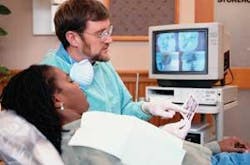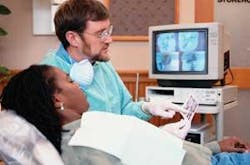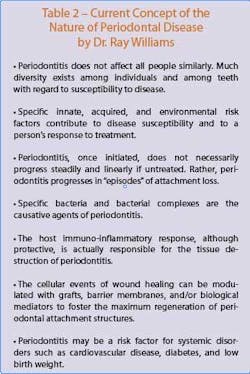Perio/hygiene for the 21st century: End-points in perio
by Dr. Steven Gutter, MBA
Part 2: Re-evaluation, Maintenance and Therapeutic Endpoints
Part 2 of this article expands the rationale for “endpoints” in perio treatment as guides in the clinical decision-making in the re-evaluation of therapy and the ongoing supportive periodontal therapy (SPT) maintenance of long-term therapeutic outcomes. Table 1 is the summary of the treatment protocol that includes the endpoints and the ADA treatment codes.
The third portion of the protocol directs attention to the heretofore largely absent re-evaluation and stabilization phase of the initial therapy. Most patients still have some sites with bleeding on probing and unresolved inflammation and pocketing after initial preparation. Full-mouth scaling and root planing (SRP), locally administered antimicrobial (LAA) treatment, and patient rinsing with chlorhexidine (CHX) for two weeks with plaque control comprise Phase 2 of this therapy. Periodontitis is a site-specific disease. To begin maintenance without periodontal stability in the mouth is premature; and yet many offices do so, even though it may not be in the patient’s best interest.
Dr. Sig Socransky, et al., at Forsyth Dental Institute, proved that periodontal pathogens are more common in shallow sites of periodontitis patients than they are in shallow sites of periodontally healthy patients. We also know there is a direct relationship between pathogens and disease. Part 1 introduced Socransky’s classic diagram of subgingival complexes (Fig. 1). In the periodontal infection, there is a sequential development of these species in plaque, which starts on the left and sets the stage for the organisms in the center (orange complex), which then sets the stage for the red complex of organisms on the right. Click here to view Table 1.
In refractory disease, there is more red complex organisms than the healthy actinomyces and strep species. One hypothesis of the cause of perio disease progression is that deep sites, which harbor these organisms, serve as reservoirs, spreading the pathogens to shallow sites. Another theory is that many shallow sites must be inhabited by the pathogens prior to the deepening of these sites. In either case, we increase the patient’s risk of progression significantly when residual organisms are left behind to cause inflammatory bleeding on probing. Therefore, further treatment is urged to reach the endpoints in the re-evaluation and stabilization third phase of the protocol.
Dr. Ray Williams, perio chair at University of North Carolina Dental School, outlines the “Current Concepts” in Table 2, as referenced in Part 1 of this series. Today’s up-to-date G.P. office knows patients do not often “feel” their perio disease. They need to be motivated to request treatment and comply with their part of the cotherapy. They must understand the treatment rationale, elect to be treated, desire to pay for the treatment, and feel they have made a great investment. Dental offices need a targeted presentation process for each patient to affect the patient as a cotherapist.
Doctor and hygienist realize that the host-modulated bacterial infection affects people and sites differently. Therapy today isn’t limited to plaque, calculus, and scraping roots, although those remain the foundation of clinical care. Today’s comprehensive treatment includes risk-factor reduction (nicotine cessation, etc.), risk profile assessment (genetic testing, medical history evaluation, medication history), antimicrobial drugs (antiseptics, e.g., chlorhexidine, povidone iodine, Listerine, local and systemic antibiotics), host modulatory therapies (low-dose doxycycline = Periostat), and immune system enhancement.
The 21st century hygiene department is armed with the World Workshop on Periodontics research that proclaims, “Chronic periodontitis is predictably controllable.” The challenge is to identify the 15 percent of the population who are highly susceptible to advanced periodontitis. If patients are diagnosed and treated early in the disease, the outcomes are most predictable, least expensive, least painful, and most likely to establish long-term control through patients’ behavior modification.
Patients’ healing response to therapy must be monitored, and unresolved sites must be retreated early and comprehensively. Perio treatment cannot be a “more expensive form of supervised neglect.” This characterization has been alleged by well-meaning periodontists who receive the patient referral when the case is almost terminal, prompting the patient to ask, “Why didn’t my general dentist send me to you earlier?”
Re-evaluation
The AAP World Workshop on Periodontics has stated, “The most clinically critical step in perio therapy is the most often overlooked aspect of treatment ... this is the re-evaluation.” Three visits are included for re-evaluation and retreatment to stabilize the patient prior to maintenance in our protocol. The ADA Code D0180 was added in 2003, specifically for the re-evaluation of the periodontal condition and response to therapy. The World Workshop in Periodontics also states, “The goal of periodontal maintenance (Code D4910) is to preserve the stable state achieved during active therapy.” This statement implies that a stable state in the patient’s mouth has been reached prior to maintenance, in order for it to be preserved. Stability, remission, or quiescence is rarely accompanied by residual bleeding and inflamed tissues. If present, leading on probing may be caused by patient medications’ side effects - so the medication history is vital information to have and to update at each recall visit.
Periodontal disease is an ongoing, never-ending condition that cannot be cured, but can only be controlled. Dr. Gary Greenstein had a thoughtful viewpoint in a 2003 issue of J. Perio where he alluded that perio disease CAN be cured. Still, that does not prevent recurrence; so his cure is equivalent to what is referred to here as stablility or “in remission.” Endpoints to therapy are used as guidelines to indicate a stable state in a mouth for now. When the disease recurs, the therapist may perform further treatment and/or perio maintenance procedures to achieve ongoing stability to prevent the patient from losing further attachment or bone. This is the only route to ultimately preserving the structural support of the teeth. The obvious outcome of maintaining today’s level of attachment and bone is tooth preservation tomorrow. Therefore, the endpoints introduced in Part 1 of this series guide re-evaluation decisions to control disease activity. They are unlike the endpoints used in restorative treatments that signal treatment has been completed; this is an important conceptual distinction.
The Four Therapeutic Endpoints listed in Table 3 indicate therapy is complete for now, and the mouth is stable. There is no endpoint described as, “We finished the fourth quadrant of SRP; that’s all the insurance company pays for, so I guess that we’re done.” Some offices begin maintenance from this point or refer to a periodontist at this point. The truth is, healthy gums don’t bleed upon gentle probing unless the medication history notes that the patient takes medication that predisposes to bleeding.
Therapeutic endpoints
It is almost impossible to remove all accretions from the teeth with SRP. Therapeutic endpoints help to answer the following questions: 1) How do we know if we’ve gotten enough off for this patient for now? 2) How do we know we have controlled the bacterial infection enough to feel comfortable that the mouth is stable, for now, and the future risk for progression is low?
Technically, the dentist/hygienist must have a high level of expertise and adequate time to succeed in lowering the bacterial challenge to within the resistance threshold of the host. Almost always, patients still have bleeding in the mouth’s 168 sites. Most likely, as Dr. Sig Ramfjord would say, “If it is still bleeding, there’s still something on the tooth that the gums don’t like. And the clinician has to get it off. And he hasn’t done so yet.” The therapeutic endpoints tell us if debridement has been thorough enough for now. The “consistent absence of bleeding on probing (BOP)” is the most reliable indicator of low risk for future breakdown (>98 percent predictive) according to Dr. Klaus Lang’s classic study from his clinic in Berne, Switzerland. Many others have corroborated his findings. This is our first endpoint, and a threshold of less than 5 percent of sites (<8 sites) BOP is a good target.A recheck is indicated at the three- and six-month visits during which more SRP and/or Arestin™ may help to control the infection. Medication history must be evaluated for drugs that pre-dispose to BOP. The list of drugs with this side effect is long, and over 50 percent of all Americans are taking multiple prescription medications. The 21st century dentists have become true “physicians of the mouth” with this medical/dental model.
A “pocket not deepening,” or no further loss of clinical attachment, is the second endpoint. This requires accurate, calibrated probing and charting of all sites. The dentist must chart the changes in probing depths and accurately document bleeding and pocketing at least once a year. Documentation of recession accurately determines clinical attachment loss (CAL). A 2 mm change in probing depth in a site over time is a major red flag that indicates disease activity has occurred in that site over that timeframe.
“Gingival collar tightening around the tooth,” the third endpoint, is indicative of an adequate host-immune response. As Saul Schulger, past perio chair at Washington University Dental School said, “Let the tissue tell you what to do.” A tight, pale pink, scalloped, knife-edged gingival margin, with tissues showing appropriate color, size, texture, contour, shape, consistency, and stippling is saying, “The immune system is capable of healing, and it has done so.”
The fourth endpoint, “Minimal volatile sulfur compounds (no halitosis),” refers to the first step in the pathogenesis of periodontal disease put forth by Dr. Perry Radcliffe, Phoenix periodontist and past professor at the Washington University perio department. The volatile sulfur gases increase the permeability of the epithelial lining of the gingival tissues, allowing both bacteria and host enzymes to enter the tissue. Halitosis often can be used to accomplish the desired patient behavior modification and compliance. The Diamond Probe and the Halimeter are diagnostic adjuncts that allow the clinician to not only determine the probing depth but also determine H2S - a volatile sulfur compound (VSC) - level in the sulcus, which indicate initial tissue injury. The VSCs are gases metabolized by the same black-pigmented bacteroides that are periodontal pathogens (Porphyromonas gingivalis, Bacteroides forsythus, et al.). The chlorine dioxide mouth rinses (Closysfrom Rowpar Pharmaceutical and Oxyfresh) and zinc-based mouthrinses (Zytexfrom Discus) chemically neutralize VSCs for 12 hours. These rinses yield an enhanced chemical reaction and get to the source of oral malodor. Patients usually appreciate and cooperate with the office in reaching this endpoint. Sharing the endpoints with patients and involving them in the treatment contribute to success.
A site-specific retreatment with SRP and/or LAA is appropriate for sites that are not resolved. Specialty referral is another option, hopefully sooner rather than later. The Endpoints provide a good tool for clinical decision making and patient involvement. Perio diseases are site-specific, and a close professional partnership with a periodontist can provide appropriate advanced care when needed during the re-evaluation phase.
Maintenance - the key to success
At the heart of perio therapy is maintenance. The dentist is always in partnership with the patient in establishing cotherapy during all phases of 21st Century Perio/Hygiene. The coexam, codiagnosis, and behavior modification begins in the first phase of the treatment protocol. The patient’s part begins with home bacterial control in Phases 1 and 2. The patient is further involved with endpoints in the Re-evaluation Phase 3 (Refer to Table 1). The AAP’s Glossary of Periodontal Terms defines maintenance as “a measurable way to permit early detection and treatment of new or recurring abnormalities or disease.”
Tooth preservation requires early diagnosis, accurate re-evaluation, re-treatment when necessary, and accurate re-evaluation again. At individually determined maintenance intervals (every two to three months in the first year or two post-active therapy), the clinician effectively monitors and activates the host response, motivates patients in the cotherapy approach, and manages the bacterial infection.
Table 4 presents the “Personalized Maintenance Therapy - Decision Matrix” by Bill Killoy, DDS, MS, and Peter Fedi, DDS, MS, past chairmen of UMKC perio department. Click here to view Table 4. This is a reference for patient education at the recall visit. The guidelines may be introduced as material presented at the American Academy of Periodontology (AAP) as the rationale for the recommendations based on each patient’s individual status presented at the continuing care visit. Treatment is based on results noted from the first three columns, i.e., probing depths, their change from the last visit, and bleeding. The matrix adds value to the SPT/maintenance visit by assuring the patient that there are clinical factors put forth by the AAP in treatment and scheduling decisions. It also reinforces the idea of remission-control, not cure, of the disease. There is no generic perio patient, as each case warrants individualized care.
Debridement with site-specific SRP at the maintenance appointment causes a slight bacteremia in the blood stream. Antibodies are recruited against the periodontal pathogens. The host receives a “booster shot” at each SPT visit. When bacteria are removed, the host-immune response is activated. LAA (Arestin, Atridox, and/or PerioChip) are also used to treat the reinfection at maintenance. Another beneficial alternative adjunct is low dose doxycycline (Periostat), used to reduce the enzymes of the destructive host response.
Conclusion
Part 2 of “Perio/Hygiene for the 21st Century” reviewed the concepts of therapeutic endpoints as a guide to decision making in perio treatment. The re-evaluation phase of treatment is included in the initial therapy protocol, premaintenance, to stabilize the mouth to a condition most predictably maintainable in health. This reduces recurrence of disease. Next month’s installment, Part 3, will discuss fees and insurance as they relate to the perio patient’s investment in the care, and the powerful financial impact our protocol has on the office’s hygiene production.
Editor’s Note: References available upon request.
Dr. Steven Gutter, MBA, has been a national consultant and speaker in the dental profession for over 20 years. He practiced in San Francisco for 10 years. He has successfully educated over 11,000 GP offices in his more than 600 presentations and consultations on Perio/Hygiene implementation, practice management, dental insurance, and dental office fee analysis. He is on the Board of Directors for The Speaking/Consulting Network (SCN), founded by Linda Miles, and is an instructor at University of Miami/Jackson Memorial Hospital’s Dental GP Residency. He can be reached at (800) 433-4907 or at www.SteveGutter.com.




